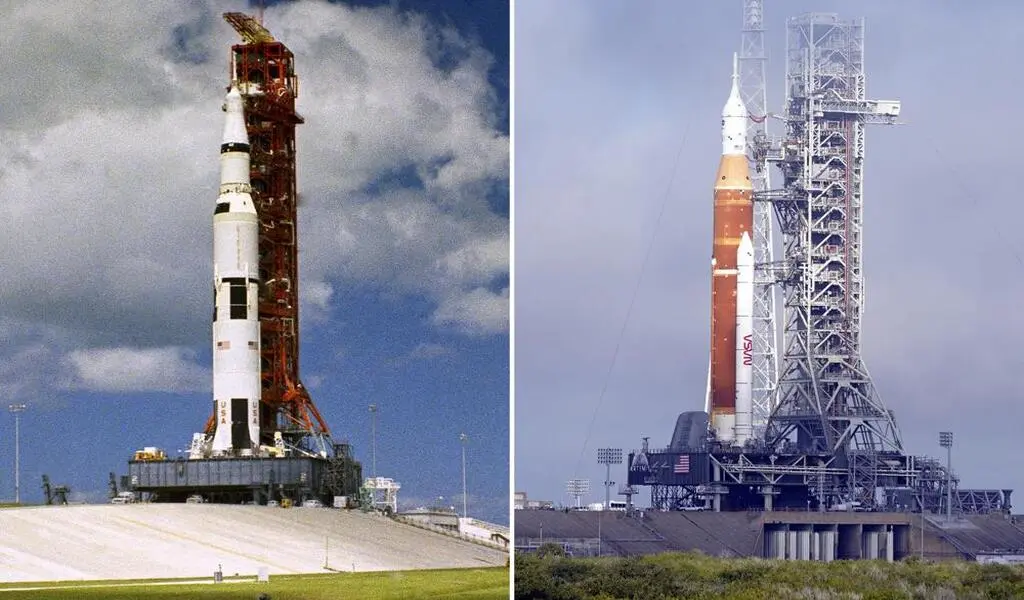(CTN NEWS) – CAPE CANAVERAL, Fla- NASA is beginning its new moon programme with a test flight of a brand-new rocket and capsule.
An early Wednesday morning launch from Florida’s Kennedy Space Center was planned. Fifty years after NASA’s illustrious Apollo moonshots, the test flight attempts to launch an empty crew capsule into a far lunar orbit.
The project is billions over budget and years late. Over $4 billion was spent on the test flight.
The new rocket and capsule, named after Apollo’s mythological twin sister Artemis, is described below as part of NASA’s Artemis programme:
ROCKET POWER
The new rocket, which has a height of 322 feet (98 metres), is shorter and slimmer than the Saturn V rocket that launched 24 Apollo astronauts to the moon 50 years ago. However, it is more powerful, with a thrust of 8.8 million pounds (4 million kilogrammes).
The Space Launch System rocket, or SLS for short, is what it is known as, though there are plans to give it a less awkward moniker. In contrast to the sleek Saturn V, the new rocket features two side boosters adapted from NASA’s space shuttles.
Similar to the shuttle boosters, the boosters start to tear off after two minutes. Before colliding with the Pacific, the core stage continues to fire. A lower stage propels the Orion spacecraft toward the moon less than two hours after launch.
MOONSHIP
The Orion constellation, one of the brightest in the night sky, is the inspiration for NASA’s high-tech, automated Orion capsule. It can accommodate four astronauts instead of three since it is taller than the Apollo capsule at 11 feet (3 metres).
A full-size dummy outfitted with acceleration and vibration sensors sits in the commander’s seat for the test flight. It is dressed in an orange flight suit.
One of the major threats of space travel is cosmic radiation, measured using two additional mannequins composed of material that mimics human tissue but lacks limbs: heads and female torsos.
Orion, as opposed to the rocket, has already taken off and orbited the Earth twice in 2014. The service module of the European Space Agency was connected to the test craft through four wings for solar power and propulsion.
FLIGHT PLAN
From its Florida launch to its Pacific splashdown, Orion’s flight is expected to endure 25 days, equivalent to astronaut journeys. Reaching the moon, which is 240,000 miles (386,000 kilometres) away, takes almost a week.
The spacecraft whips by the moon and then enters an orbit with a far point of 38,000 miles (61,000 kilometres). Based on that, Orion would be farther from Earth than Apollo at 280,000 miles (450,000 kilometres).
The major test occurs when Orion enters the atmosphere at the end of the mission while travelling at 25,000 mph (40,000 kph) on its way to a splashdown in the Pacific.
The heat shield can endure reentry temperatures of 5,000 degrees Fahrenheit by using the same material as the Apollo capsules (2,750 degrees Celsius). However, the sophisticated design accounts for future Mars colonists’ speedier and hotter returns.
HITCHHIKERS
The test trip also carries several stowaways for deep space exploration and the three test dummies. Once Orion is rushing toward the moon, ten tiny satellites the size of shoeboxes launch.
Given these little spacecraft’s low cost and high danger, NASA anticipates that some may fail.
Orion is carrying some moon rocks that Neil Armstrong and Buzz Aldrin from Apollo 11 acquired in 1969, as well as a rocket engine bolt that was recovered from the sea ten years ago in a gesture of the past.
ARTEMIS VS. APOLLO
Apollo continues to be regarded as NASA’s finest accomplishment more than 50 years later.
Armstrong and Aldrin landed on the moon in just eight years thanks to NASA’s use of technology from the 1960s after Alan Shepard, the agency’s first astronaut, was launched into space.
In contrast, despite building on the short-lived Constellation lunar exploration programme, Artemis has been going on for more than ten years. From 1969 to 1972, twelve Apollo astronauts made twelve trips to the moon, each lasting no more than three days.
NASA is extending the time crews spend on the moon to at least a week for Artemis and will select astronauts from a diverse astronaut pool. The objective is to establish a sustained lunar presence that will smooth the way for manned missions to Mars.
WHAT COMES UP NEXT
Before astronauts return to the moon, much work is still to be done. Possibly as early as 2024, a second test flight will send four astronauts around the moon and back.
NASA plans to launch four more around a year later, with two landing at the lunar south pole.
Like the Apollo spacecraft, Orion lacks a built-in lunar lander, so NASA has contracted with Elon Musk’s SpaceX to supply its Starship spacecraft for the first Artemis moon landing.
Two additional private businesses are developing moonwalking suits. A pair of astronauts would be transported to the moon’s surface by the futuristic-looking Starship before returning to the capsule for the return trip to Earth.
Starship has only travelled six miles so far (10 kilometres).
RELATED CTN NEWS:
NASA Artemis I Plans To Launch This Week Despite Hurricane Damage






